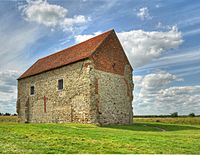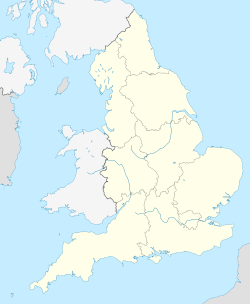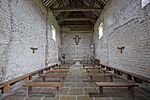Chapel of St Peter-on-the-Wall facts for kids
Quick facts for kids Chapel of St Peter-on-the-Wall |
|
|---|---|
 |
|
| 51°44′07″N 0°56′24″E / 51.73536°N 0.93994°E | |
| Location | Essex |
| Country | United Kingdom |
| Denomination | Church of England |
| History | |
| Status | Active |
| Architecture | |
| Functional status | Chapel |
| Heritage designation | Grade I listed building |
| Designated | 30 December 1959 |
| Specifications | |
| Other dimensions | wall thickness 2.5 feet (0.76 m) |
| Administration | |
| Parish | looked after by the parish church of St Thomas Bradwell-on-Sea |
| Diocese | Diocese of Chelmsford |
The Chapel of St Peter-on-the-Wall, Bradwell-on-Sea, is a Christian church dating from the years 660–662 and among the oldest largely intact churches in England. It is in regular use by the nearby Othona Community, in addition to Church of England services. It is a Grade I listed building.
History
According to Bede (who wrote his history in the early 8th century), a 'city' named Ythanceaster existed on the River Penta. The Chapel of St Peter-on-the-Wall was almost certainly originally built by Bishop Cedd in 654. It was an Anglo-Celtic church for the East Saxons, set astride the ruins of the abandoned Roman fort of Othona. The current structure was most likely built around 654–662, incorporating the Roman bricks and stones. In 653 Cedd travelled south from Lindisfarne to spread Christianity at the behest of Sigeberht the Good, then King of the East Saxons, and, having been ordained as a bishop, returned the next year in order to build the chapel, and probably others too. Following the death of Cedd in October 664 from plague, the chapel became part of the Diocese of London.
No further record exists of the chapel being used until 1442, when the local clergy reported to the Bishop of London that it had been expanded slightly, with a small tower above the porch with a bell in it. However they did not know of its origins and it was unusable, having been burnt. It was repaired and returned to regular use alongside the parish church in Bradwell-on-Sea until at least the Tudor period (16th century) before falling into disuse as a church again and being used as a barn—the position of the wide barn doorway, now filled in, can be seen on the south side of the nave.
In 1920 it was restored and reconsecrated as a chapel. It was designated as a Grade I listed building in 1959.
In May 2023 a book entitled St Peter-on-the Wall Landscape and Heritage on the Essex Coast was published. It reflected concerns over the planned Bradwell B nuclear power station, which it was feared would damage the local environment and the setting of the Chapel.
Current use
The chapel belongs to Chelmsford Cathedral and is looked after by the Chaplain, the Revd Steven Poss, Rector of the parish church of St Thomas Bradwell-on-Sea, and members of the church. Regular public services are held in the chapel each week with a Thursday morning Communion service at 9 am. Special services are held at Christmas and Easter. In the summer evening services are held each Sunday in July and August at 6:30 pm.
The chapel and adjacent field are the home of the Bradwell Pilgrimage, held on the first Saturday in July. The procession starts at the Parish Church of St Thomas and the pilgrims walk to the Chapel of St Peter's, where services and events are held.
The chapel is also used by the nearby Othona Community. Founded in 1946 by Norman Motley, rector of St Michael, Cornhill, 1956–1980, this Christian-based community is open to people of all faiths and none.
In 2018 the chapel was the location for two music videos by the boys' choir Libera.
The chapel is the end point of St Peter's Way, a 45-mile (72 km) footpath starting at Chipping Ongar.
See also
 In Spanish: Capilla de Saint Peter-on-the-Wall para niños
In Spanish: Capilla de Saint Peter-on-the-Wall para niños





